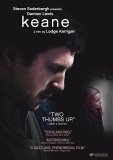William Keane (Lewis) has apparently lost his daughter, abducted from a New York Subway station. The film opens with a frantic Keane searching for anyone who might have seen her. But did any of it really happen? At first Damian Lewis’s performance completely sells the abduction. Every nuance of his acting tugs at our heartstrings for his horrible loss. His incessant searching and constant probing of his own memory draws us deeper and deeper emotionally into the set-up. It doesn’t take us very long at all to questio… the event and Keane’s sanity. In short time the story begins to unravel along with Keane’s mind. Again, it is a superb performance by Lewis that makes it all so real. It is this compelling performance that makes any of this interesting to us at all.
Keane, both the film and the man, is a detailed character study into the mind of a seriously troubled man. His troubles run far deeper than the possible missing child. Barely surviving in a hotel room with no job, we soon learn he is on some kind of disability. We are pretty sure what that’s all about. Keane spends a great deal of his time either drunk or high on coke. While it is almost impossible to have any kind of sympathy for this man, we are hooked into caring what happens to him, and more importantly what he might do next. Perhaps it’s the same concept as watching a train wreck, because we never believe this story’s going to end well for Keane or the young mother and daughter he befriends at the hotel. With this relationship our suspicious nature is aroused. Now we’re never really sure if Kean’e state of mind is a result of the substance abuse, or rather the reverse. A meltdown in a bar and a growing paranoia starts to scare the hell out of us, yet we simply can’t look away. Again, credit Lewis and his amazing performance.
There isn’t any score to this film, and a very minimal use of source music. Somehow the style choice adds a dry but somewhat appropriate edge to the film. Our moments spent in obscene close-up shots of Keane are unsettling. As he gets closer to his neighbor and more importantly her 7 year old daughter, we begin to suspect the horrifying worst. Writer/director Lodge Kerrigan gives us a small thread of hope at first. It seems the relationship is having a calming effect on Keane. Still, each moment he spends alone with the innocent and trusting child leaves us on the edge of our seats, waiting for our fears to be realized. Likely the film will not end exactly as you suspect, but it is one of the most moving film endings since they put down Old Yeller.
Video
Keane is presented in its original 1.78:1 aspect ratio. The glaring flaw is the abundance of grain found throughout the film. I admit, the grainy picture likely works well in creating the overall effective feel of the film. Colors are fair, but black levels suffer primarily from the grain. The film is often dark, and unfortunately detail is not sharp. However, the many close-up shots of Lewis do often present a new level of detail that only highlights a terrific performance. Fortunately, in these shots we see every facial movement perfectly. There aren’t any print or compression artifacts that I found.
Audio
The Dolby Digital 5.1 track is surprisingly aggressive for such a tight character study. Ambient sounds, while subtle, work their way into the tapestry of sound in such a way as to create a wonderful but eerie realism to the entire film. No real work here for your subs, but the dynamic range is impressive. Dialogue is often low and quite mumbled, but you will hear every word as clearly as Kerrigan wants you to.
Special Features
Apparently Steven Soderbergh received an advance copy of the film from Kerrigan and supplied an alternate cut, which is mysteriously provided here. This cut is about 20 minutes shorter and never captures our attention, let alone our imagination, the way the original does. Missing the entire crucial opening sequence, we never get drawn into Keane’s psychosis the way we are intended to. Steven, stick to your own work. Keane is fine in its original form and I highly recommend you skip this alternative cut.
Final Thoughts
This film certainly deserves far more attention than it has or is likely to get, even with this DVD release. Kerrigan’s intimate filming style is just the perfect choice for the film’s mood. Of course, this decision might have never come close to the atmosphere it provides if not for the fantastic job of acting by Lewis. Buy it or rent it, I don’t care, but you simply have to see this film “one way or another”.
Special Features List
- Alternate cut by executive producer Steven Soderbergh





